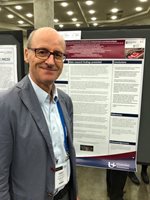
A safe and effective drug that has dramatically reduced incidence of blindness caused by the parasitic disease onchocerciasis also could help eliminate debilitating and sometimes deadly forms of epilepsy that are increasingly linked to the same infection,
according to a presentation on Monday at #TropMed17.
“Onchocerciasis-associated epilepsy is a major public health problem that is completely neglected in many parts of Africa,” said Robert Colebunders, an infectious disease professor at the University of Antwerp Global Health Institute.
Colebunders presented evidence from the Democratic Republic of Congo (DRC) showing that epilepsy was twice as common in children living in onchocerciasis-endemic areas that had not been targeted with the anti-parasitic drug ivermectin. He also examined epilepsy rates in an area where ivermectin was administered twice a year as part of mass drug treatment campaigns targeting river blindness. Colebunders noted that a potentially deadly form of epilepsy called nodding syndrome, which had been occurring at unusually high rates, “stopped completely.”
The name of the condition is a reference to muscle atrophy in the neck linked to the syndrome that makes it difficult for victims to hold their heads up.
Onchocerciasis is caused by a type of worm or “filarial” transmitted to humans via a bite from the blackflies that swarm around streams and rivers in various parts of sub-Saharan Africa. It’s often called river blindness because the parasites can release toxins in the eye that, after many years of exposure, can lead to blindness.
Colebunders said there is increasing evidence that onchocerciasis also can cause neurological damage that leads to epilepsy, including nodding syndrome.
Blindness caused by onchocerciasis has been significantly reduced by administering ivermectin prophylactically to the populations of entire villages in areas where infection is common. Colebunders believes regular treatment with ivermectin—along with spraying larvicides in rivers where blackflies breed-- also is the key to eliminating onchocerciasis-associated epilepsy.
Colebunders said there could be hundreds of thousands of people in sub-Saharan Africa suffering from onchocerciasis-associated epilepsy that could have been prevented if they had been treated as children with ivermectin.
He said there is an urgent need to intensify ivermectin campaigns because, while developing river blindness can require two decades of exposure to onchocerciasis, epilepsy can develop after only five or six years. He said the onset of onchocerciasis-associated epilepsy typically is seen when children enter primary school. Also, Colebunders said there is evidence that preventing epilepsy requires administering ivermectin twice a year, while prevent river blindness may only require one round per year.
Colebunders offered vivid illustrations of the suffering that may be linked to onchocerciasis-associated epilepsy. He showed a picture of a man from the Democratic Republic of Congo standing in front of his house where he recounted burying 10 of his 13 children who died from complications of nodding syndrome. Colebunders also showed pictures of what appeared to be young children who were actually adults in their mid-20s who had suffered stunting as the result of epilepsy linked to onchocerciasis.
“We need much more advocacy for this very important issue,” he said.
The University of Antwerp’s Global Health Institute
held a workshop last month on onchocerciasis-associated epilepsy and is convening a consortium of scientists to conduct more research on the problem and share their findings.